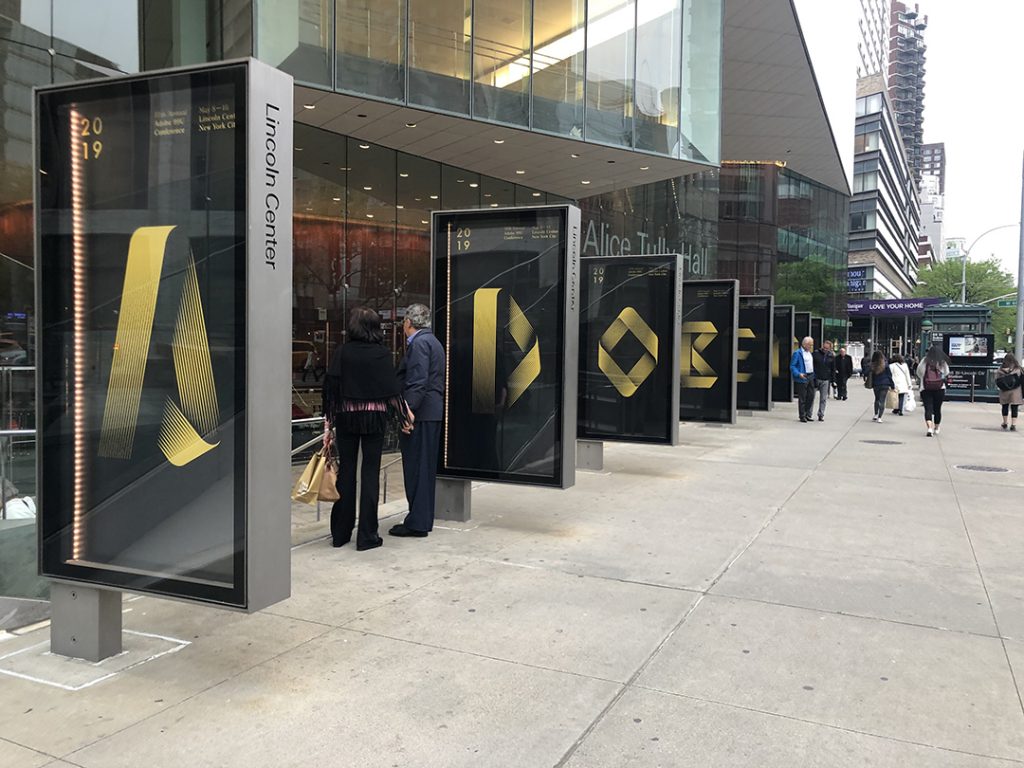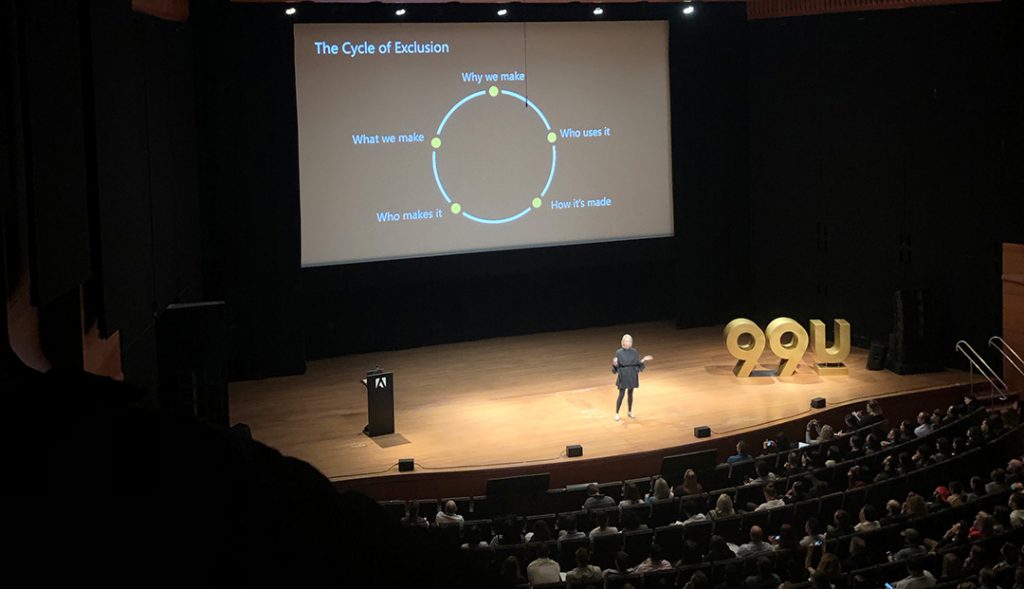Foerstel CCO, Claudia Button, recently attended Adobe’s 99U conference and this was her takeaway.
Creativity is futureproofed. It’s human. It’s global. It’s technology-agnostic. It doesn’t discriminate. From people working at the bleeding edge of their fields to others bringing more humanity to technology and business, Adobe’s 11th Annual 99U Conference in New York City was a call to action for creatives to take control of our tomorrow. In a series of main stage talks and performances over two days, we’ve heard from leaders and groundbreakers across the fields of inclusive design, augmented intelligence, sonic design, data humanism, poetic computation, and brand voice. We learned about The Creative Future, but most importantly, that it is HUMAN:

• Poetic computation – Could you imagine how the human voice would look like if you could actually see it in a spatial context? Zach Lieberman, co-founder of Manhattan’s School of Poetic Computation, has been exploring just that. He creates performances and installations by exploring the lyrical possibilities of code. By demystifying tools and treating code as creative writing, Zach and the artists attending this innovative school create bizarre, extraordinary works of art that blend technology and aesthetic craft, fueled by creative inquiry.
• Data doesn’t exist – It is proxy for something else. It is not perfect. It’s human. Giorgia Lupi, Partner & Design Director of Accurat, a data-driven design firm with offices in Milan and New York (as well as a Partner at Pentagram), works with data visualization using an empathic meditative language. Believing that creating things that help humanity is design’s highest calling, Giorgia created Bruises: The Data we Don’t See; a series of beautifully laid out visuals of a little girl’s battle with a rare disease. By collecting clinical data as well as emotional responses, thoughts, fears, and hopes, this narrative took the form of flowering buds tracing a visual depiction of someone’s very intense experience.
• AI is now only the tool – Build something that can continue beyond you and make a difference in future generations. Dr. Vivienne Ming believes that creativity is what makes us unique. That is your only value. What is important is that you can have an idea that no one else would have had. Machines can turn those ideas into reality. But the visions are ours. Humans. The only issue is having the guts to share that vision to the world, because few of us have the courage to do what is right, creatively. Our job, she argues, is not our purpose. It is like planting trees. Why do it, when we know that we’ll never rest under the shade of that tree? “You want an amazing life? Then give it to someone else.”

• Make time for boredom – Artist and illustrator Kile T. Webster started his talk by laying down on the stage, doing…Nothing. The average American today spends eleven hours a day interacting with media, mostly screen time. What if there was no email, no Netflix, no Slack? It would give us time to be bored, to space out. And when humans get bored, their medial pre-frontal cortex gets more active because they are relaxed and are not busy doing a task. Down time actually gets our imagination active, because our subconscious mind, which works on 100 billion neurons as opposed to the 86 billion of the conscious one, is at work to solve problems. Boredom, as Webster puts it, is a “beautiful, blank, unexplored space that we will probably lose altogether if we are not careful. We need to seek it out and bask in it.”
• Stop thinking multitasking is a thing – Dr. Sahar Yousef, a cognitive neuroscientist at UC Berkeley gave insightful advice on how to protect our most precious assets: Time, focus, and energy. While work strategies have evolved, our brains have not, and so we find ourselves struggling to keep on task while office life demands us to “multitask’ (impossible – we did a test to prove that), keep focus in an open-office environment (a Harvard study showed how they are productivity killers because of the constant interruptions and distractions), and to concentrate on specific tasks for long periods of time (doing short, focus “sprints” instead will ensure better productivity).
• Yes! And.. – Duncan Wardle, former Head of Innovation at Disney took the audience through a high-energy talk to show how ideas are born. Have you ever taken the freeway to go home after a day in the office and realized that you have no recollection of the past 5 minutes? When we are on auto pilot, there are no ideas coming in. “No fresh stimulus in? No new ideas out!” he argues. Try switching your commute. Go on a road you have never been on. Try a different food for lunch or start listening to a new radio station. One of the best brainstorming techniques I have learned in the conference was the “Yes, and..” one. Once a group is brainstorming to come up with ideas, the best way to keep the conversation going is to approach the naysayers who utter “No, but” and ask them to respond with a “Yes, and..” which eliminates negativity and no-can-do attitudes. Wardle also discussed how he, believing that the future is human, persuaded Disney to keep the figure of a receptionist and redefine it as “Director of First Impressions.”
• Diversity is being invited to the party. Inclusivity is being invited to dance – The conversation of inclusivity took many forms at the Conference. Kat Holmes, founder of Mismatch.design, a firm dedicated to inclusive design resources and education, argues that when we design for inclusivity we have to have a conversation with those who have the most to lose in terms of independence and ask: Whose voices are missing? In another talk, Michael Ventura talked about empathy. This emotion is what the future of creativity is all about: When we design for people, empathy makes us look to ourselves “to see what’s up with us” and then we go outward, into the past, to others, and into the future. Ventura, founder and CEO of Sub Rosa, a creative studio in New York City, believes that meaningful solutions can only come from Applied Empathy, a platform pioneered by him and his team, that helps individuals get “closer to themselves, through thoughtful questions and inspired conversation.” Finally, Chronicle Books Executive Publishing Director Christina Amini inspired us all with her lesson on how to give a Pep Talk when collaborators are feeling not-so-great about themselves:
1. Pay Attention
2. Ask questions
3. Open your heart
4. Listen actively
5. Be honest
6. Encourage questions
7. Cheer. YAY YOU!

The 2019 99U conference left me inspired and confident that human creativity is FUTURE PROOFED. As Global Head of Music Jamal Dauda and Senior Designer Karen van de Kraats of WeTransfer put it, People First. Creativity Second. Technology Third. YAY US!

